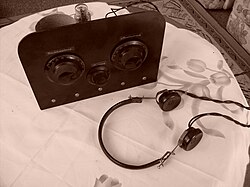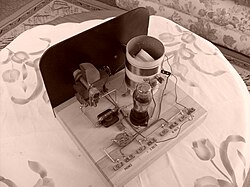Regenerative circuit


The regenerative circuit (or self-regenerative circuit) allows an electronic signal to be amplified many times by the same vacuum tube or other active component such as a field effect transistor.
History
The inventor of FM radio, Edwin Armstrong, invented and patented the regenerative circuit while he was a junior in college, in 1914. He patented the super-regenerative circuit in 1922, and the superheterodyne receiver in 1918.
Lee De Forest filed a patent in 1916 that became the cause of a contentious lawsuit with the prolific inventor Armstrong, whose patent for the regenerative circuit had been issued in 1914. The lawsuit lasted twelve years, winding its way through the appeals process and ending up at the Supreme Court. The Court ruled in favor of De Forest, although the experts agree that the incorrect judgement had been issued.[citation needed]
At the time the regenerative receiver was introduced, vacuum tubes were expensive and consumed lots of power, with the added expense and encumbrance of heavy batteries or AC transformer and rectifier. So this design, getting most gain out of one tube, filled the needs of the growing radio community and immediately thrived. Although the superheterodyne receiver is the most common receiver in use today, the regenerative radio made the most out of very few parts.
In WW2 the regenerative circuit was used in some early military equipment. A related circuit, the super-regenerative detector, found wide use in WW2 in military Friend or Foe identification equipment and in the top-secret proximity fuse, which had a very important role in winning the war for the allies.
Superheterodyne receiver
In 1906, Reginald Fessenden had already used a version of the heterodyne principle for broadcasting.
When the parts became easier to obtain, the superheterodyne receiver replaced the regenerative radio for all serious work. Then radio industry matured and prices dropped with increased production. In 1930 the superheterodyne design began to supplant the regenerative receiver, and after WWII it was almost completely phased out of mass production, remaining only in hobby kits.
Operating limits
Quality of a receiver is defined by its sensitivity and selectivity. For a single-tank TRF (tuned radio frequency) receiver without regenerative feedback, , where Q is tank "quality" defined as , Z is reactive impedance, R is resistive loss. Signal voltage at tank is antenna voltage multiplied by Q.
Positive feedback compensates the energy loss caused by R, so we may express it as bringing in some negative R. Quality with feedback is . Regeneration rate is .
M depends on stability of amplification and feedback coefficient, because if R-Rneg is set less than Rneg fluctuation, it will easily overstep the oscillation margin. This problem can be partly solved by "grid leak" or any kind of automatic gain control, but the downside of this is surrendering control over receiver to noises and fadings of input signal, which is undesirable. Note that modern semiconductors offer much more stability than vacuum tubes of the 1920s.
Actual numbers: To have 3 kHz bandwidth at 12 MHz (short waves travelling all around Earth) we need . A two-inch coil of thick silvered wire wound on a ceramic core may have Q up to 400, but let's suppose Q = 100. We need M = 40, which is attainable with good stable amplifier even without power stabilizing.
Super-regenerative receiver
The super-regenerative receiver uses a second lower frequency oscillation (within the same stage or by using a second oscillator stage) to provide single device circuit gains of around one million. This second oscillation periodically interrupts or "quenches" the main RF oscillation, allowing the RF signal to be built up over and over. Strictly speaking, the main RF oscillation still occurs: the detector starts to build up the incoming RF oscillation up to and slightly above oscillation level. But the net result is that most of the time the detector is amplifying the RF signal and is creating a free running RF oscillation in only a small portion of its quenching cycle. A big difference between a straight regen and a super regen is that there is no heterodyne (no squealing interference) as the set is tuned and operated.
The super regen uses far fewer components than more complex designs and it is easily possible to build VHF, UHF, and even microwave radio receivers that operate at microwatt power levels. These are ideal for remote sensing applications or where very long battery life is essential. For many years, super regenerative circuits have been used for commercial applications such as garage-door openers, radar detectors, microwatt RF data links, and very low cost walkie talkies.
On the other hand, in the normal operating mode a super-regenerative system has an inherent contradiction limiting its use to relatively free and clear bands. Due to Nyquist's theorem its quenching frequency must be at least twice the signal bandwidth. But quenching with overtones acts further as a heterodyne receiver mixing additional unneeded signals from those bands into the working frequency. Thus the overall bandwidth of super-regenerator cannot be less than 4 times that of the quench frequency, assuming the quenching oscillator produces an ideal sinewave.
However, recent experiments have shown that the self quenched super regenerative circuit may be operated at a level in between the regenerative and super-regenerative states. At these levels, something very interesting happens: A received narrow band FM (RF) signal can be set to heterodyne with the super regen detector's RF oscillations such that sum and difference frequencies are produced. The difference frequency, if close to the detector's quenching oscillation frequency, will lock onto and FM modulate the quench frequency. This produces a large variation in gain which exactly follows the FM modulation of the received signal. The gain variation creates a frequency to amplitude conversion (FM detection) of very high efficiency. To date, this effect has only been studied by electronics experimenters but could eventually lead to very high frequency, ultra low power FM receivers.
Patents
- Armstrong, E. H., U.S. patent 1,113,149, Wireless receiving system, 1914.
- Armstrong, E. H., U.S. patent 1,342,885, Method of receiving high frequency oscillation, 1922.
- Armstrong, E. H., U.S. patent 1,424,065, Signalling system, 1922.
- Braden, R. A., U.S. patent 2,211,091, Superregenerative magnetron receiver, 1940.
Footnotes
See also
External links
- Some Recent Developments in the Audion Receiver by EH Armstrong, Proceedings of the IRE (Institute of Radio Engineers), volume 3, 1915, pp.215-247.
- a one transistor regenerative receiver





